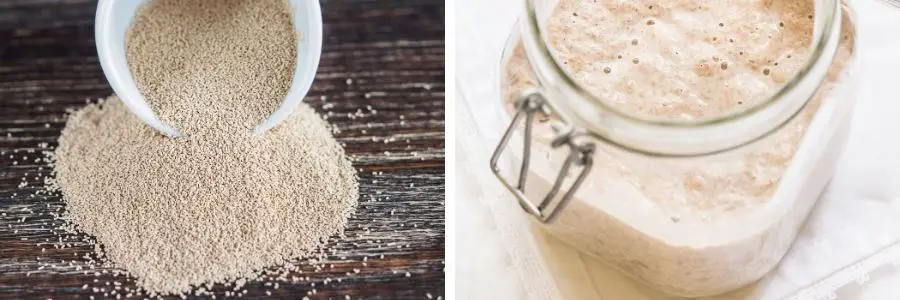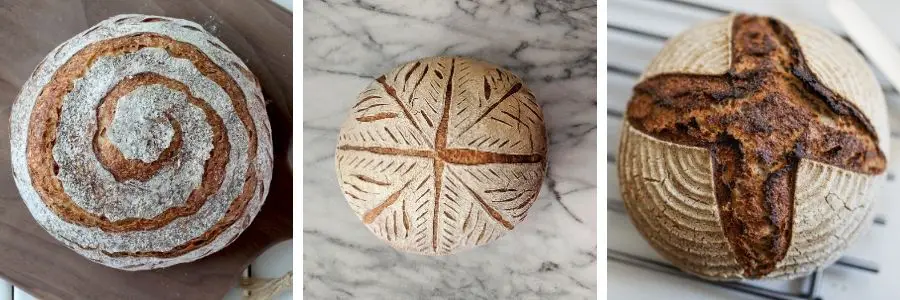Although sourdough is made using an ancient process, it’s only become a very fashionable way to make bread in recent years.
Also known as artisan bread, sourdough is popping up everywhere you look, from micro-bakeries to the supermarket shelf.
If you’ve never made sourdough or looked into the process of how it’s made you may be wondering what all the fuss is about. So what’s the difference between sourdough and normal bread?
The difference between sourdough and a ‘normal bread’ made from yeast is the fermentation process and the artisan methods that go into making it. Instead of yeast, sourdough is leavened using a sourdough starter which creates a slow fermentation in the bread dough. Sourdough uses simple ingredients and has a unique flavour and chewy texture.
Read on to find out more about the differences between a sourdough and yeast bread ingredients along with more information about the artisan techniques which are used to create sourdough bread.
So, what is a sourdough starter?
Although the sourdough process can seem a bit daunting, it’s actually really simplistic, it just requires time and nurturing to create what is effectively something amazing from something that’s so basic.
It all starts with a sourdough starter, which is the basis of sourdough bread and what creates the fermentation process which yeast would do in regular bread dough.
The starter is usually made in a jar by mixing a small amount of flour and water together, the jar is then sealed and left to ferment.
Fermentation occurs when microorganisms feed on the carbohydrate found in the flour, turning it into alcohol or acids.
The sourdough starter is regularly ‘fed’ with more flour and water to boost the fermentation process and increase the starter.
During this process bubbles of gas develop in the starter, regular feeding helps the sourdough starter become more and more active.
In some cases starters can become so active the lid can burst off the jar or it can spill out.
It can take two or three weeks for a sourdough starter to become read for use. Once the sourdough starter is ready, it can be used in the sourdough recipe to act as a raising agent in the dough instead of yeast.
You can use any type of bread flour in the starter, wholemeal flour tends to ferment better than white flour, but white will still work too.
Some bakers use grapes or apple to boost the process, personally I like to use just flour and water to keep the ingredients as basic as possible.
What’s the difference between yeast and a sourdough starter?
The fermentation process in yeast is actually similar to the fermentation process in sourdough, but the difference is you don’t need to add the additional yeast ingredient to the dough mix.
Yeast also contains microorganisms which ferment, produce by-products and gas bubbles which help the dough to rise.
Using yeast to make bread is much quicker than using sourdough, especially if you use a fast-acting dried yeast.
As soon as it’s added to the dough and kneaded, it’s active and ready and can make the dough double in size within an hour if the room is at the right temperature.
Sourdough can take many hours to rise and prove to the right level, but it’s this very slow fermentation process which creates all the flavour.

What ingredients do you need for sourdough
The beauty of sourdough bread it that it can be made using just three ingredients which are flour, water and salt for flavour.
The sourdough starter is made from flour and water and you just need to add that to more flour and water along with some salt to create an amazing sourdough loaf.
It’s sometimes difficult to believe that something which looks and tastes so good can be made from such simple ingredients, but this is what makes sourdough a truly artisan process.
Other ingredients can be added depending on the recipe, but I just wanted to explain how good sourdough can be in it’s purest form.
TIP: Not sure if you have all the necessary bread baking equipment at home? Check out my recommended picks below (Amazon links):
-
- Scale: Nicewell 22lb Digital Kitchen Scale
- Mixing Bowls: OXO Stainless Mixing Bowls Set
- Pastry Scraper: OXO Stainless Pastry Scraper
- Loaf Pan: OXO Non-stick Loaf Pan
- Kitchen Thermometer: ThermoPro Digital Thermometer
- Stand Mixer (optional): Kenwood Kmix Stand Mixer
What different techniques are used to make sourdough
Before making a sourdough loaf, it’s best to feed the sourdough starter the day before you use it to bake it become more active.
Sourdough starters can be kept in the fridge when not being used to keep it dormant and stop it from going off.
If you’ve been storing a sourdough starter in the fridge you’ll need to take it out 24 hours before it’s used to liven it up.
An amount of sourdough (around 300g) depending on the recipe is added to more bread flour, water and salt and kneaded as usual.
The dough is then left to rise for many hours before it’s knocked back and proved (proofed or risen again).
Before proving the dough for a second time, the sourdough is often shaped and placed into a proving basket where it can prove into the shape of the final loaf.
This prevents the dough from spreading out as it rises for many hours. Using a proving basket also helps to create a decorative effect on top of the dough.
Creating patterns on sourdough bread
Creating patterns on sourdough bread is becoming a form of art and there are many YouTube channels dedicated to bread artwork which is created using a simple razor-like tool called a lame.
As well as being decorative, the patterns and lines which are slashed onto the top of a sourdough loaf also have a functional purpose, in that they help the bread to expand as it’s baked in the oven.
Although patterns and slashes can be made on many types of bread dough, it has become a mark of the sourdough especially when it’s made to be sold.

You might also like…
I hope this post has helped you learn a little bit about the differences between sourdough and normal bread.
You might also like to have a look at the following posts:
